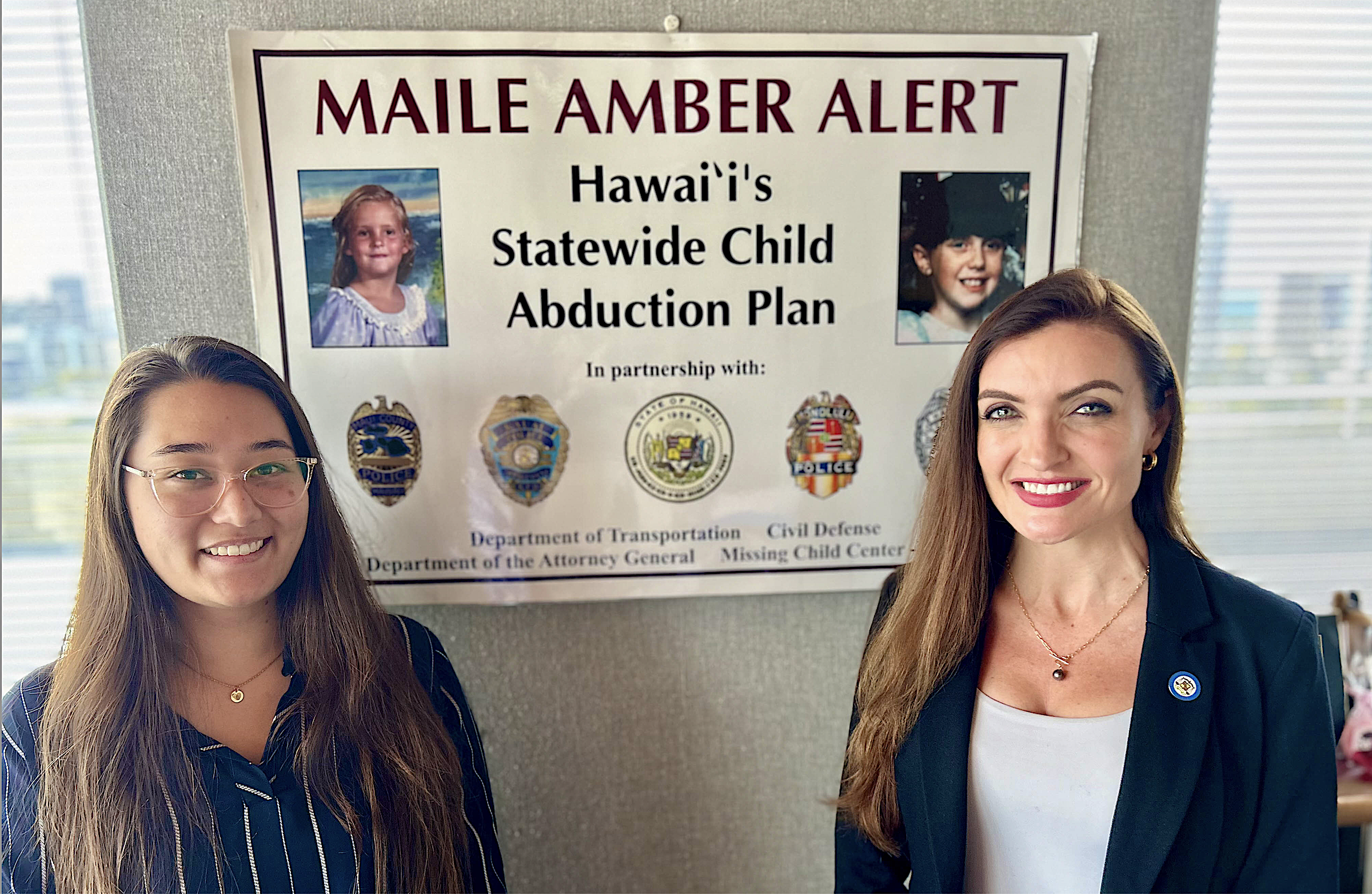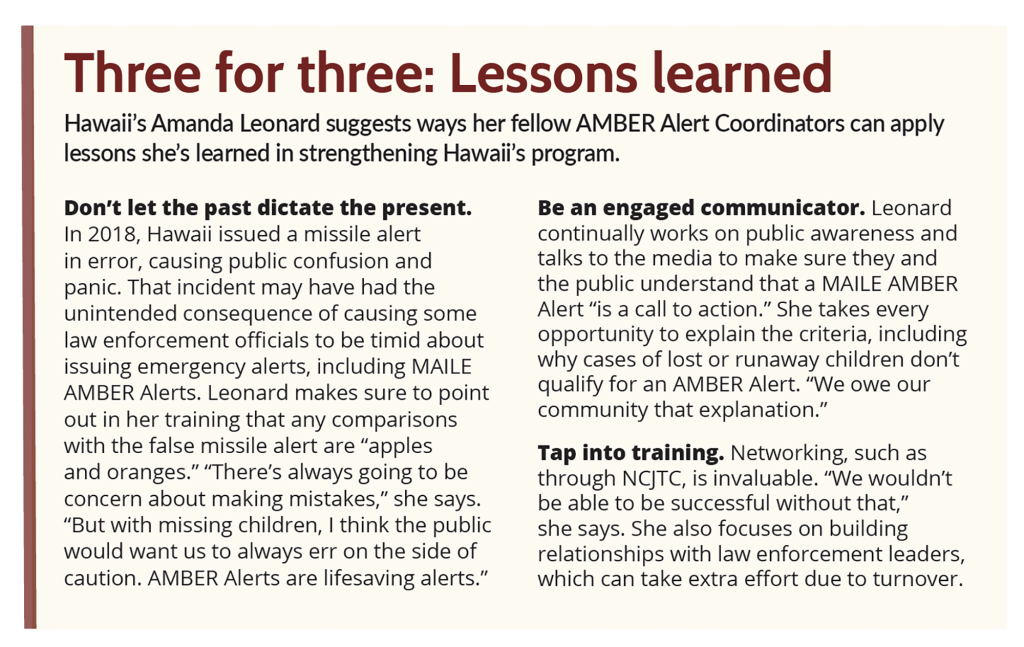
By Jody Garlock
When the Honolulu Police Department issued a MAILE AMBER Alert in February 2024 for two brothers whose mother reported them missing and in potential danger, not even HPD officers could have predicted such a swift recovery. Within five minutes of the alert’s distinct alarm sounding on cellphones across Oahu Island, the mother’s former boyfriend said he would surrender the 10- and 11-year-old boys in a gas station parking lot. The case serves as a testament to the power of AMBER Alerts—or, as it’s called in Hawaii, the MAILE AMBER Alert, named in memory of 6-year-old Maile Gilbert (see “Three for three: lessons learned,” below) who was abducted and murdered in 1985, prior to the alert’s existence.
“With alert activations in a state like Hawaii with an isolated population, we find that abductors may feel the pressure to turn themselves in after either seeing the alert or being told there is one,” says Amanda Leonard, coordinator of the Missing Child Center Hawaii and statewide MAILE AMBER Alert Coordinator. Additionally, as in this case, local news reports stated that customers at the gas station who received the alert had promptly called in sightings to police.

Soon after police arrived at the scene, the mother and her boys were able to drive away safely in the gray Honda Odyssey. The van belonged to the mother, who had given the former boyfriend permission to use it and take the boys on an errand. When he failed to return the children and stopped answering her calls after an argument, she contacted police. A subsequent report of a family member learning the man had struck one of the boys in the face, and therefore they may be in danger, escalated the case to meet the criteria for a MAILE AMBER Alert. The 54-year-old suspect was not immediately charged.
This recent case is the latest in a string of MAILE AMBER Alerts in a state that historically has had none. And for Leonard, it also serves as an example of the importance of public awareness and quick-thinking citizens willing to be an extra set of eyes to help keep children safe.
“Part of our culture here is really about family and children,” Leonard says. “We pride ourselves in not just looking out for our own children, but other people’s children in our community.”
Case by case
Hawaii put its MAILE AMBER Alert system in place in 2005, becoming the final state to join the nationwide AMBER Alert program. In a ceremony with Hawaiian officials, Tracy Henke, who at the time was Acting Assistant Attorney General for the U.S. Department of Justice’s Office of Justice Programs, called the establishment of statewide AMBER Alert plans in all 50 states “a landmark achievement that makes America’s children safer.”
Just four months later, the state had its first activation. In that case, a 4-month-old baby was safely recovered in Honolulu thanks to an attentive delivery truck driver. The driver had received a message about the missing infant from his dispatcher after an office worker saw the alert. (This was before the text-like wireless emergency alerts, or WEAs, began appearing on phones in subsequent years.) He spotted the stolen pickup truck, which had been abandoned with the infant safe inside.
Seventeen years then went by without any MAILE AMBER Alerts. Leonard speculates that had more to do with a lack of understanding about the program than about no cases meeting the criteria for issuing an alert. So when she began working at the Missing Child Center in 2018, she made it her mission to build relationships and enhance the education and training—including monthly tests of the system—with the state’s four county police departments. (In January, Hawaii’s statewide police force became operational; it stems from a 2022 bill then-Governor David Ige signed into law in an effort to allow more efficient and effective emergency response.) The MAILE AMBER Alert program will remain under the Hawaii Department of the Attorney General.
“We started to really revamp and aggressively work on improving our program with the help of the National Criminal Justice Training Center [NCJTC],” Leonard says.

Preparedness pays off
In September 2022, authorities faced their most dramatic case—a rare stranger abduction that garnered national attention. This marked the first MAILE AMBER Alert on Hawaii Island, and also was the first time the state used a WEA to alert the public. A 15-year-old girl who was at a beach on the Big Island was forced at knifepoint to tie up her boyfriend and was led through a wooded area and across lava fields to the abductor’s vehicle. The man took her to his home on the opposite side of the island some 70 miles away, where he chained her up in an old school bus on the property.
As a massive air and ground search, which included volunteers from the community who galvanized after receiving the MAILE AMBER Alert, continued the next day, the teen convinced her abductor to take her to a café in the nearby town of Hilo to get something to eat. The café host felt something seemed off when he first spotted the duo, then it clicked: “That’s the AMBER Alert girl!” he yelled as he rushed to grab the girl from the man’s grasp and safely whisk her to a back room in the café.
Another person began taking photos as the abductor fled in his SUV. A few hours later, authorities arrested 52-year-old Duncan Mahi, who witnesses identified in a photo lineup. Mahi remains in custody as he awaits trial for charges that include kidnapping and sexual assault.
“It was really incredible,” Leonard says of the two citizens who were dubbed the “Hilo Heroes.” When Leonard asked them what gave them the courage to intervene knowing the man was armed, they both said they felt compelled by the MAILE AMBER Alert. “The café host said he responded in the way he would want someone else to respond if it had been his little sister or cousin,” she says. “It was definitely a testament to the power of the program and the Big Island community.”
 On the heels of that case, about five months later the Maui Police Department issued its first MAILE AMBER Alert. In February 2023, an island-wide alert was disseminated for a 3-month-old boy whose mother had fled with him after the father was granted sole legal and physical custody. Shortly after the alert was issued around 2 a.m., authorities received a tip on the whereabouts of the mother, who was wanted for custodial interference and was in violation of a temporary restraining order between herself and the child. The baby was safely recovered.
On the heels of that case, about five months later the Maui Police Department issued its first MAILE AMBER Alert. In February 2023, an island-wide alert was disseminated for a 3-month-old boy whose mother had fled with him after the father was granted sole legal and physical custody. Shortly after the alert was issued around 2 a.m., authorities received a tip on the whereabouts of the mother, who was wanted for custodial interference and was in violation of a temporary restraining order between herself and the child. The baby was safely recovered.
“We have a 100 percent success rate so far—knock on wood,” Leonard says. “When you look at these three consecutive alerts, I think it shows we’re on the right track.”
Partnering for a cause
For Leonard, the fact that Hawaii has had an increased number of alerts—with about 300 recoveries a year when factoring in other types of missing children cases—is a direct correlation to increased education and training. “The criteria for issuing a MAILE AMBER Alert did not change—it was the program development that we’ve worked on since 2018 that changed,” she says.
Leonard considers partnerships with organizations such as the NCJTC a key to success. National and regional NCJTC meetings have provided training by national experts, the ability to meet survivors from across the country, and valuable networking.
“We wouldn’t be able to be successful without those partnerships and being able to meet other folks who have our jobs in other states,” she adds. “It’s been absolutely instrumental.”
She also praises the dedication of law enforcement authorities and those working on behalf of children who consider their work a lifestyle and a calling more than a job.
“There’s no better feeling than getting a call that a child has been safely located alive,” Leonard says. “It makes me feel like we have one of the most important jobs in our state.”
Remembering Maile

The “MAILE” acronym in Hawaii’s AMBER Alert program is in memory of 6-year-old Maile Gilbert, who was abducted by a family acquaintance from her Kailua home and murdered in August 1985. MAILE stands for “Minor Abducted in Life-threatening Emergency.”
Hawaii opted to add a local connection to the national AMBER Alert program—created as a legacy to 9-year-old Amber Hagerman. Amber’s 1996 abduction and murder in Arlington, Texas, sparked nationwide efforts to prevent future incidents.
